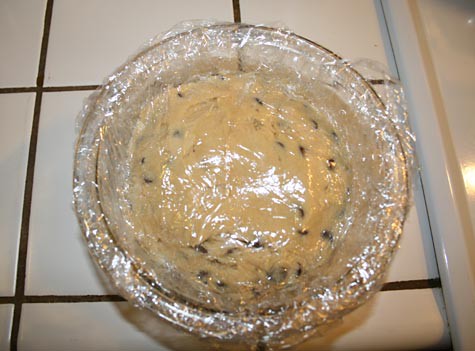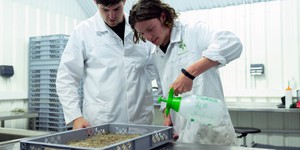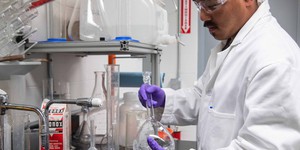Abstract
Have you ever bitten in to a cookie and thought, "this is the best cookie in the whole wide world!"? Was it one you made at home? In this science fair project, discover if you can perfect the taste of your favorite cookie right in your own kitchen!Summary
Sandra Slutz, PhD, Science Buddies
This science fair project was inspired by: Leite, D. (2008, July 9). Perfection? Hint: It's Warm and Has a Secret. The New York Times. Retrieved August 27, 2008 from http://www.nytimes.com/2008/07/09/dining/09chip.html?
Chocolate-chip cookie recipe courtesy of Nestle Toll House.
- Nestlé® and Toll House® are registered trademarks of Société des Produits Nestlé S.A., Vevey, Switzerland.

Objective
Run a taste test to find out if letting cookie dough sit in the refrigerator for 48 hours before baking it makes cookies taste better.
Introduction
Everyone has a favorite cookie. Some prefer peanut butter, others choose chocolate-chip, oatmeal raisin, or even gingersnap, and the list goes on! Whatever your favorite type of cookie is, you're probably always eager to try another batch to figure out what the "best" version of that cookie is. In this science fair project, you can continue your quest for the "best" cookie by exploring whether a small change in your cookie recipe changes the flavor.
First let's examine what goes into a cookie. All cookies have dry ingredients and wet ingredients. The exact ingredients depend on the cookie recipe, but in general, the dry ingredients include items like flour, baking soda, and salt. The wet ingredients can be liquids, like milk or water, or even butter or eggs, which although they aren't exactly liquids, they are "wet." Both butter and eggs contain a lot of water. For butter, 20 percent of the total weight is water. And eggs have even more water—74 percent!
To make the cookie dough, the dry and wet ingredients are combined. The result is a mixture that is wet enough that it doesn't crumble, but dry enough that it doesn't ooze into a puddle. If you were to magnify the cookie dough hundreds of times under a microscope, you would see little bits of wet and dry ingredients sitting next to one another—they'd be jumbled together, but they'd still be separate ingredients. But, if you let the cookie dough sit for a while, something new happens. The water from the wet ingredients actually goes into the dry ingredients—it is absorbed—similar to how a sponge absorbs a puddle of water.
When the dry ingredients absorb some water from the wet ingredients, all the ingredients become more similar, which results in cookie dough that is more uniform and thus, cooks more evenly. But does that result in a better tasting cookie? You can find out in this science fair project by conducting a taste test! You'll make two batches of cookies: one where the dough is allowed to sit in the refrigerator for two days before it is baked, and one where the cookie dough is baked right away after you mix the ingredients together. The cookie dough batch that will sit for two days must be refrigerated while the dry ingredients absorb water from the wet ingredients, otherwise the dough might start to spoil and would be unsafe to eat. Once you've made both batches of cookies, you'll have your friends and family taste cookies from each batch and tell you which one they like better. Which cookie do you think will taste better? Mix, refrigerate, and bake to find out!
Terms and Concepts
- Batch
- Recipe
- Ingredient
- Microscope
- Absorb
- Taste test
- Spoil
- Blind taste test
Questions
- Which are the dry ingredients in your favorite cookie recipe, and which are the wet ingredients?
- What is a blind taste test?
- Why might it be better to run a blind taste test instead of a taste test where the tasters know the difference between the things they are tasting beforehand?
- Why do some foods (like cookie dough) spoil when they are not refrigerated?
Bibliography
For more information about cookie recipes and the science of baking, consult a cookbook or try one of these websites:
- Leite, D. (2008, July 9). Perfection? Hint: It's Warm and Has a Secret. The New York Times. Retrieved August 27, 2008.
- Anusasananan, L.; Baker, A.; and Hal, C. (2005). The Perfect Chocolate Chip Cookie. Sunset. Retrieved August 27, 2008.
This website offers help with creating graphs:
- National Center for Education Statistics. (n.d.). Create a Graph. Retrieved August 27, 2008.
Materials and Equipment
- Mixing bowls (3)
- Electric mixer or mixing spoon
- Measuring spoons
- Measuring cup
- Plastic wrap
- Refrigerator
- Cookie sheet
- Oven
- Optional: Wire cooling rack
- Ingredients to make two batches of your favorite cookie recipe. If you don't have a favorite cookie recipe, you can try the chocolate-chip cookie recipe below in the Experimental Procedure.
- Cookie tins or other containers to hold baked cookies (2)
- Volunteers to taste-test the cookies (at least 10 people, not including yourself)
- Paper to make taste-test questionnaire (one piece of paper for each volunteer)
- Pencils, pens, or other writing utensils (one for each volunteer)
- Lab notebook
- Graph paper
Experimental Procedure
Deciding on a Cookie Recipe
Note: many science fairs require that you do a quantitative experiment, whereas the taste-test procedure suggested is qualitative. Check with your science teacher to see if you need to do a quantitative project. See the last point on the Make It Your Own tab for an idea on how to make this project more quantitative.
To start this science fair project you will need to gather together all the ingredients necessary to make two batches of your favorite cookie recipe. If you don't have a favorite, or if you want to try a new recipe, here is one for Nestlé® Toll House® Chocolate-Chip Cookies:
- This table has the ingredients you'll need:
| Ingredient | Quantity for One Batch | Quantity for Two Batches |
| All-purpose flour | 2 ¼ cups | 4 ½ cups |
| Baking soda | 1 teaspoon | 2 teaspoons |
| Salt | 1 teaspoon | 2 teaspoons |
| Butter or margarine, softened | 1 cup | 2 cups |
| Granulated white sugar | ¾ cup | 1 ½ cups |
| Packed brown sugar | ¾ cup | 1 ½ cups |
| Vanilla extract | 1 teaspoon | 2 teaspoons |
| Eggs | 2 | 4 |
| Semi-sweet chocolate chips | 1 (12-ounce) package | 2 (12-ounce) packages |
- To make the cookie dough, combine the flour, baking soda, and salt in a small mixing bowl. In a second bowl, use a spoon or electric mixer to beat the butter, granulated white sugar, packed brown sugar, and vanilla extract until the mixture is creamy. Add the eggs to the butter mixture, one at a time, beating well after each one is added. Gradually add the flour mixture into the butter mixture. Continue to mix the dough until it is well combined. Stir in the chocolate chips.
- To bake the dough, preheat the oven to 375°F. Drop tablespoon-sized mounds of cookie dough onto an ungreased cookie sheet. Bake for 9-11 minutes, or until golden brown. Let the cookies cool on the cookie sheet for 2 minutes, then place them on a wire cooling rack. Leave the cookies on the cooling rack until they are completely cool to the touch.
Making the Cookies
Read the instructions carefully. It'll be at least three days between the time you start the experiment and when you conduct the taste test. Make sure to plan the timing of things so that the cookie-dough resting, baking, and taste-testing are all done on the correct days.
-
With the help of an adult, follow the cookie recipe to make one batch of cookie dough.
- Do not bake this dough.
- Put the dough in a small mixing bowl.
- Cover the top of the dough with a layer of plastic wrap. Make sure the wrap is actually touching the dough and not just stretched over the top of the bowl. This will prevent the cookie dough from drying out. For added protection, add a second layer of plastic wrap on top. The bowl of cookie dough should look like the picture in Figure 2.
 Image Credit: Sandra Slutz, Science Buddies / Science Buddies
Image Credit: Sandra Slutz, Science Buddies / Science Buddies
Figure 2. Before putting the cookie dough in the refrigerator, cover the dough with two layers of plastic wrap. Make sure the plastic wrap is in direct contact with the dough, as shown in this picture.
-
Refrigerate the batch of cookie dough for 48 hours (two days). Make sure that the cookie dough is stored in the refrigerator the whole time and not left out on the counter. Unrefrigerated cookie dough is not safe to eat or bake!
- This batch will be your refrigerated cookie dough.
- It will be ready to be baked in two days. For example, if you made the dough Friday night it would be ready to bake on Sunday night.
-
Once the refrigerated cookie dough has been in the refrigerator for 48 hours, bake it, as directed by your recipe. Because ovens are different, note down in your lab notebook for exactly how long you baked the cookies by the time they were done.
- Important: Let the refrigerated dough sit on the counter for 1 hour to warm back up to room temperature before baking.
-
Immediately after baking the batch of refrigerated cookie dough, make a second batch of cookie dough. This will be the freshly made cookie dough. Bake this batch of cookies right away for exactly as long as you baked the refrigerated batch.
- Use the same recipe, oven setting, ingredient brands, cooking time, and cookie sheet for both batches of cookies.
- Make sure to keep the cookies from the two batches separate from one another so that you don't mix them up.
- As soon as the refrigerated cookie dough cookies are cool, it is a good idea to move them to a cookie tin or other container. Label the container "1" to indicate it was the first cookie batch you made. This will help prevent you from mixing up the two batches of cookies.
- When the freshly made cookie dough cookies are cool, move them to a second container labeled "2."
- At the end of the second day, you will have two batches of cookies baked, cooled, and stored in labeled cookie tins or containers. Now you're ready for the taste test!
- The taste test does not have to be conducted the same day you bake the cookies. The cookies can be stored in airtight containers for up to two days before conducting the taste test.
Taste-Testing and Analyzing the Data
- Once both the refrigerated and the freshly made cookie batches are baked and cooled, you're almost ready for the taste test.
-
Prepare a brief questionnaire on pieces of paper to hand out to each volunteer, as well as writing utensils. The questionnaire should include the following questions:
- Do you detect a difference in flavor between the two cookies?
- Do you prefer the flavor of the cookie from container 1 or container 2?
- Tell the volunteers that you are conducting a taste test between two batches of cookies. Do not tell them what the difference between the batches is. Have the volunteers take a cookie from the refrigerated cookie dough batch in container "1." Ask them to eat the cookie, paying careful attention to how it tastes.
-
Next, have the volunteers take a cookie from the freshly made cookie dough batch in container "2." Ask them to eat the second cookie, also paying careful attention to how it tastes.
- The volunteers might appreciate a glass of water (or milk) to drink between their cookies—this is fine and will help them enjoy each cookie more.
-
Ask the volunteers to fill out their questionnaires and hand them back to you.
- Record their answers in a data table, in your lab notebook.
- Once you've recorded their answers, you can tell your volunteers what the difference was between the two cookie batches, but don't do this in the hearing of other volunteers whom you haven't tested yet!
- Note: Feel free to sample your cookies and see if you detect a difference between the two batches, but do not include yourself in the data table because you already know what the difference is between the two cookie batches. You only want data from people who are uninformed about the experiment.
Fill in the boxes below, which correspond to the answer each volunteer gives: Volunteer Difference in flavor?
Yes / NoPrefer cookie #1 (refrigerated) or cookie #2 (freshly baked)? #1 #2 -
Once you've gathered all your data, you are ready to analyze it.
- Make a bar graph showing your data. There should be three bars, one for each possible answer.
- You can make the bar graph by hand or use a website like Create a Graph to make the graph on the computer and print it.
- Did most of the people detect a difference in taste between the two batches of cookies? Which batch of cookies did your volunteers prefer: the refrigerated cookie dough batch or the freshly made cookie dough batch?
Ask an Expert
Variations
- What types of differences do people detect between the two cookie batches? Repeat the experiment above, this time asking people who prefer one batch of cookie over the other what they think is the difference between the two batches. Do they taste different? How? Do they have different textures?
- Try this experiment with several different types of cookies. Make refrigerated and freshly made batches of each type of cookie. Are the results the same across different types of cookies?
- Do you think refrigerating for a period of time would affect other types of baking? Design an experiment to find out!
- How many chocolate chips can you add before the cookies begin to fall apart? Can you come up with a way to consistently test how strong the cookies are?
Careers
If you like this project, you might enjoy exploring these related careers:










